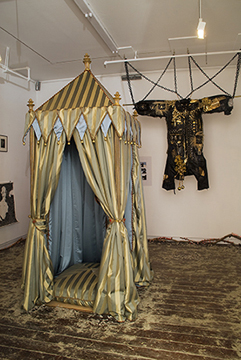
The show I most wanted to see this past year but didn’t was AA Bronson‘s School For Young Shamans at John Connelly Presents. It seems to have culminated from, or at least focused, the recent critical mass of queer artists interested in magic (or magick, if you’re an acolyte of Aleister Crowley). The show combined early and recent work by Bronson, along with two collaborations (a soothsayer tent with Scott Treleaven and two joined stalls connected by a glory hole with Terence Koh) and work by Christophe Chemin, Michael Dudeck, Scott Hug, Item Idem, Sands Murray-Wassink, Naufus Ramirez-Figueroa, J.X. Williams, Bruce Labruce, and Andrew Zealley. When I first became aware of the show, a month or two in advance of its opening, all I could think was that I wanted to matriculate (two videos of the deeply convivial Bronson discussing the exhibition can be viewed here and here).
Amongst the several unfinished essays littering my desktop that I still fantasize about finishing is one about magic and contemporary art. Initially galvanized by Scott Treleaven‘s exhibition, My Dear, My Darling, Do You Hear Me Where You Sleep, at Kavi Gupta Gallery in 2006, I’d intended the essay as a cheeky response to what was then the hot topic in my graduate painting seminar, the apparent schism between theory and practice in contemporary art. The problem was felt at the time as an either/or choice between theory (resulting in artworks merely illustrating ideas gotten from elsewhere, particularly literature and philosophy departments) and practice (with the consequence of churning out pretty but dumb market fodder). Lane Relyea was one of my professors at the time, and his essays, “Allover and At Once” (X-Tra, vol. 6, no. 1, Fall 2003) and “Theory and Painting” (Flash Art, vol. 37, no. 239, Nov.-Dec. 2004), helped me understand that particular fork in the road as a false choice. In fact, I still find those essays to be useful maps for navigating this particular minefield in contemporary art.
So how does one magically rejoin theory and practice? For starters, magic stakes itself on practice; it is meaningless apart from rituals, spells, and other material activities. And imputing magical efficacy to art causes artists to clarify their intentions and take responsibility for their artworks’ effects, whether real, exaggerated, or imagined. Magical thinking makes less visible aspects of art objects–like politics and context–magically appear by pushing intention and result into the foreground. That is the moral, so to speak, of William S. Burroughs’ famous sentence: “It is to be remembered that all art is magical in origin–sculpture, writing, painting, and by magical I mean intended to produce very specific results.” Whenever I look at an artwork, I like to ask what kind of spell is it casting, and if it is achieving the desired result.
I don’t really have any speculations as to why the overwhelming majority of artist-magicians working right now are queer (or why so many queer artists are interested in magic or, if not magic, then with re-enchanting art, i.e. Paul P., Hernan Bas, etc.). “Gay Witches, pt. 2” will list some of my favorite current practitioners and projects…




Pingback: Gay Witches, pt. 2 | Art21 Blog